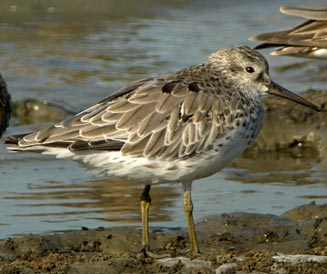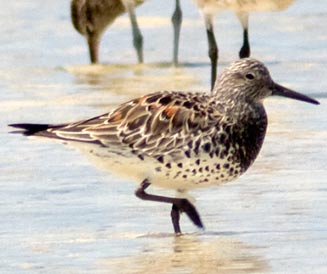|
Calidris tenuirostris (Great
knot)
Grootknoet [Afrikaans]; Grote kanoetstrandloper,
[Dutch]; Bécasseau de l'Anadyr [French]; Großer knutt [German]; Gallinago
media (Great snipe) Dubbelsnip [Afrikaans]; Poelsnip [Dutch]; Bécassine double
[French]; Doppelschnepfe [German]; Narceja-real [Portuguese]
Life
> Eukaryotes >
Opisthokonta
> Metazoa (animals) >
Bilateria >
Deuterostomia > Chordata >
Craniata > Vertebrata (vertebrates) > Gnathostomata (jawed
vertebrates) > Teleostomi (teleost fish) > Osteichthyes (bony fish) > Class:
Sarcopterygii (lobe-finned
fish) > Stegocephalia (terrestrial
vertebrates) > Tetrapoda
(four-legged vertebrates) > Reptiliomorpha > Amniota >
Reptilia (reptiles) >
Romeriida > Diapsida > Archosauromorpha > Archosauria >
Dinosauria
(dinosaurs) > Saurischia > Theropoda (bipedal predatory dinosaurs) >
Coelurosauria > Maniraptora > Aves
(birds) >
Order: Charadriiformes > Family: Scolopacidae
 |
 |
|
Great knot in non-breeding plumage, Queensland,
Australia. [photo Ryan Shaw ©] |
Great knot in breeding plumage, Olango Bird
Sanctuary,
Philippines. [photo
Luis V. Limchiu ©] |
Distribution and habitat
Breeds in north-eastern Siberia, heading south in the
non-breeding season to the area between Australasia and Pakistan, while a
vagrant to Europe, North Africa and southern Africa. Here it an individual was
present at the coastal mudflats of Langebaan Lagoon, Western Cape in four
consecutive summers from 2000-2003.
References
-
Hockey PAR, Dean WRJ and Ryan PG 2005. Roberts
- Birds of southern Africa, VIIth ed. The Trustees of the John Voelcker
Bird Book Fund, Cape Town.
|
